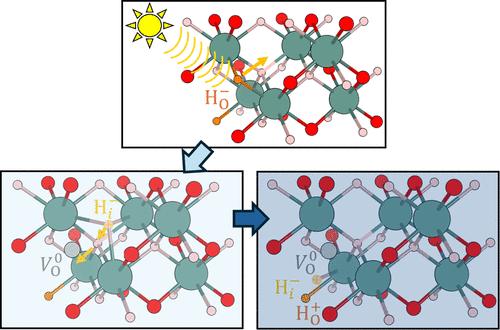当前位置:
X-MOL 学术
›
J. Phys. Chem. C
›
论文详情
Our official English website, www.x-mol.net, welcomes your
feedback! (Note: you will need to create a separate account there.)
Defect Properties, Anion Ordering, and Photochromic Mechanism in Yttrium Oxyhydride
The Journal of Physical Chemistry C ( IF 3.3 ) Pub Date : 2024-11-17 , DOI: 10.1021/acs.jpcc.4c04988 Andrew J. E. Rowberg, Chris G. Van de Walle
The Journal of Physical Chemistry C ( IF 3.3 ) Pub Date : 2024-11-17 , DOI: 10.1021/acs.jpcc.4c04988 Andrew J. E. Rowberg, Chris G. Van de Walle

|
Yttrium oxyhydride (YHO) undergoes a reversible photochromic transition when exposed to ultraviolet light. However, the mechanism for this transformation is not fully understood, and the structure and precise chemical composition of YHO remain under debate. Here, we use first-principles density functional theory calculations with a hybrid functional to study the structure, chemical stability, and point defect properties of YHO. As experiments have shown, we find that YHO prefers a cubic structure, with H and O anions present in equal concentrations and located on tetrahedral sites. Stoichiometric and ordered YHO is chemically stable, but it has a wide band gap of 5.01 eV, considerably larger than that measured in experiments (2.4–3.8 eV). On the other hand, Y4H10O has a smaller band gap of 2.97 eV and also has a region of chemical stability; thus, the actual material may include some fraction of this H-rich structure. The defect chemistry of YHO is dominated by anionic antisite species (HO and OH), with hydrogen interstitials (Hi) and vacancies (VH) also present in reasonably high concentrations. We show that antisite disorder lowers the band gap relative to the perfectly ordered structure, bringing the magnitude of the gap into closer agreement with experiment. Based on our calculations of defect migration and the positions of defect states relative to the band edges, we link the onset of photochromic behavior to the reaction HO– → VO0 + Hi–, which follows photoexcitation of a HO+ defect. Hi– can subsequently migrate away and be trapped by additional HO+ defects, contributing to the persistence of the reaction, while the resultant oxygen vacancy, VO0, introduces an occupied defect state that leads to optical absorption at visible wavelengths. Our results can explain reported discrepancies between experimental and computational results for YHO, and they allow us to propose specific atomic-scale processes that can lead to photochromism. Understanding these mechanisms is key for unlocking YHO’s application in devices ranging from smart windows and optoelectronics to electrochemical synapses for neural networks.
中文翻译:

氧氢化钇的缺陷特性、阴离子排序和光致变色机制
氢氧化钇 (YHO) 在暴露于紫外线时发生可逆的光致变色转变。然而,这种转变的机制尚不完全清楚,YHO 的结构和精确的化学成分仍在争论中。在这里,我们使用第一性原理密度泛函理论和混合泛函来研究 YHO 的结构、化学稳定性和点缺陷特性。正如实验表明的那样,我们发现 YHO 更喜欢立方结构,H 和 O 阴离子的浓度相等,位于四面体位点。化学计量和有序 YHO 化学性质稳定,但其宽带隙为 5.01 eV,比实验中测得的 (2.4–3.8 eV) 大得多。另一方面,Y4H10O 的带隙较小,为 2.97 eV,并且还具有化学稳定性区域;因此,实际材料可能包括这种富含 H 的结构的一些部分。YHO 的缺陷化学以阴离子反物质 (HO 和 OH) 为主,氢间隙 (H) 和空位 (VH) 也以相当高的浓度存在。我们表明,相对于完美有序的结构,反位点无序降低了带隙,使间隙的大小与实验更加一致。根据我们对缺陷迁移的计算和缺陷状态相对于带边缘的位置,我们将光致变色行为的开始与 HO + 缺陷光激发后的反应 HO – → VO0 + H– 联系起来。 H– 随后可以迁移出去并被额外的 HO + 缺陷捕获,从而有助于反应的持久性,而由此产生的氧空位 VO0 引入了占据缺陷状态,导致可见光波长的光吸收。我们的结果可以解释 YHO 的实验和计算结果之间报告的差异,并且它们使我们能够提出可能导致光致变色的特定原子尺度过程。了解这些机制是解锁 YHO 在从智能窗户和光电子到神经网络电化学突触等设备中的应用的关键。
更新日期:2024-11-18
中文翻译:

氧氢化钇的缺陷特性、阴离子排序和光致变色机制
氢氧化钇 (YHO) 在暴露于紫外线时发生可逆的光致变色转变。然而,这种转变的机制尚不完全清楚,YHO 的结构和精确的化学成分仍在争论中。在这里,我们使用第一性原理密度泛函理论和混合泛函来研究 YHO 的结构、化学稳定性和点缺陷特性。正如实验表明的那样,我们发现 YHO 更喜欢立方结构,H 和 O 阴离子的浓度相等,位于四面体位点。化学计量和有序 YHO 化学性质稳定,但其宽带隙为 5.01 eV,比实验中测得的 (2.4–3.8 eV) 大得多。另一方面,Y4H10O 的带隙较小,为 2.97 eV,并且还具有化学稳定性区域;因此,实际材料可能包括这种富含 H 的结构的一些部分。YHO 的缺陷化学以阴离子反物质 (HO 和 OH) 为主,氢间隙 (H) 和空位 (VH) 也以相当高的浓度存在。我们表明,相对于完美有序的结构,反位点无序降低了带隙,使间隙的大小与实验更加一致。根据我们对缺陷迁移的计算和缺陷状态相对于带边缘的位置,我们将光致变色行为的开始与 HO + 缺陷光激发后的反应 HO – → VO0 + H– 联系起来。 H– 随后可以迁移出去并被额外的 HO + 缺陷捕获,从而有助于反应的持久性,而由此产生的氧空位 VO0 引入了占据缺陷状态,导致可见光波长的光吸收。我们的结果可以解释 YHO 的实验和计算结果之间报告的差异,并且它们使我们能够提出可能导致光致变色的特定原子尺度过程。了解这些机制是解锁 YHO 在从智能窗户和光电子到神经网络电化学突触等设备中的应用的关键。


















































 京公网安备 11010802027423号
京公网安备 11010802027423号